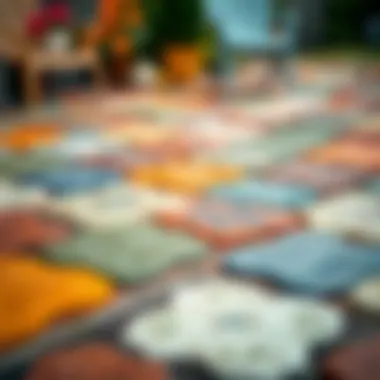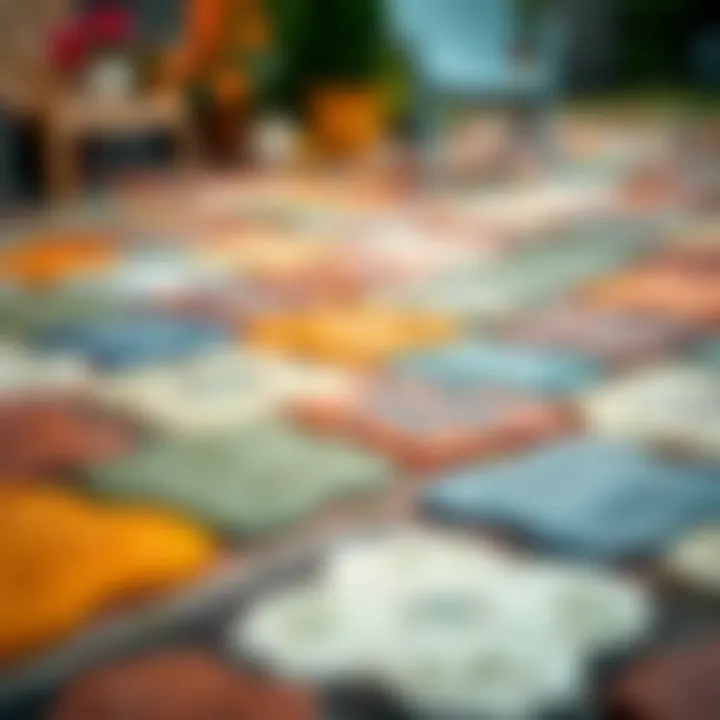A Comprehensive Guide to Removable Patio Tiles


Intro
Creating inviting outdoor spaces has gained traction in recent years, and one of the pivotal elements contributing to this trend is the choice of flooring. Removable patio tiles have carved a niche in the world of outdoor design, serving not just as functional flooring options but also as aesthetic enhancements that allow homeowners to express their unique styles. These tiles offer flexibility, making them ideal for those who want to adjust their outdoor environments according to seasons or occasions.
Understanding the significance of removable patio tiles goes beyond mere functionality. It encompasses the ability to play with design, materials, and maintenance while being sensitive to environmental concerns. This guide aims to shed light on the multifaceted aspects of these tiles, from buying recommendations to their design trends. Whether you're a homeowner hoping to revamp your backyard, a designer looking for innovative ideas, or a DIY enthusiast keen on projects, there’s a wealth of information covered here to help you make informed and thoughtful choices.
Intro to Removable Patio Tiles
In the realm of outdoor design, removable patio tiles have carved out a niche that combines functionality with aesthetic appeal. As homeowners increasingly look to enhance their outdoor spaces, these tiles offer a practical solution that caters to various needs. From easily changing the look of a patio without committing to permanent flooring, to offering simple installation options for DIY enthusiasts, the significance of removable patio tiles cannot be overstated.
They empower individuals to craft personalized environments with relative ease, bringing versatility and style to outdoor areas. The demand for spaces that reflect personal aesthetic preferences has surged, motivating an exploration into materials, designs, and installation methods specific to removable flooring.
As we dive deeper into this guide, we will illuminate various facets of removable patio tiles, from defining what constitutes these tiles to tracing their historical journey and evolution, alongside the innovations that shape their ever-expanding presence in contemporary landscape design.
Defining Removable Patio Tiles
Removable patio tiles are specially designed flooring panels that can be installed and removed with minimal effort. Unlike traditional tile installations that require permanent adhesives and mortar, these tiles often feature interlocking systems or snap-together designs that allow for quick assembly and disassembly. This flexibility is particularly appealing to homeowners who want to customize their outdoor settings or need seasonal options for changing weather conditions.
The materials used for these tiles vary, presenting choices from wood to plastic, ceramic to composite. This diversity means that one can find options that not only suit practical needs but also complement various design aesthetics.
To put it simply, removable patio tiles redefine what’s possible in outdoor spaces. They open doors to creativity while being sensible for maintenance and storage.
Historical Context and Evolution
The concept of flooring that can be altered or replaced isn’t entirely new, but the modern iteration of removable patio tiles began to gain traction in the late 20th century. Early examples of portable flooring primarily catered to temporary installations at events and public spaces rather than residential settings. Often made from heavy materials, these tiles were bulky and not user-friendly.
However, as outdoor living gained popularity, so did the innovations behind removable tiles. Advances in materials, like lightweight plastics that mimic natural stone, allowed for products that were more appealing and utilitarian.
Today, manufacturers have embraced technology, offering non-slip finishes, UV-resistant coatings, and designs that account for the elements, allowing for durability and style. This marked shift illustrates a growing recognition of the importance of outdoor spaces as extensions of the home, making removable patio tiles a staple for adaptable design.
The evolution has been fueled by consumer demand for versatile, aesthetically pleasing solutions. Homeowners are now more educated about their choices, seeking options that not only serve their functional needs but also align with modern design principles.
For more in-depth information, consider exploring resources like Wikipedia on Patio Tiles or articles on Britannica about Outdoor Design.
From their definitions to their historical significance, removable patio tiles reflect a unique blend of convenience, creativity, and contemporary design sensibilities.
Benefits of Removable Patio Tiles
Removable patio tiles offer a range of advantages that appeal to homeowners, designers, and DIY enthusiasts alike. As outdoor spaces become extensions of our homes, the need for functional, aesthetically pleasing, and flexible flooring options has never been clearer. In this section, we will unpack the significant benefits of using removable patio tiles, focusing on their design versatility, ease of installation and removal, as well as their cost-effectiveness.
Versatility in Design
One of the standout features of removable patio tiles is their ability to enhance the aesthetic appeal of outdoor spaces without being overly restrictive. These tiles come in a myriad of colors, textures, and patterns, allowing for creativity and personalization. Whether one prefers a bold, modern look or a classic, understated design, there's a removable tile option out there that can seamlessly fit into the desired theme.
- Wide Variety of Materials: With options ranging from wood to composite, homeowners can choose materials that align with their environmental values and style preferences.
- Patterns and Layouts: The modular nature of these tiles means that one can experiment with different patterns or orientations. This feature allows for unique designs that can impress guests and elevate the ambiance of outdoor gatherings.
- Seasonal Adjustments: One interesting aspect is that design preferences may shift with the seasons. Removable tiles can be swapped out to match seasonal décor, providing a fresh feel without the need for a complete overhaul of the outdoor space.
Ease of Installation and Removal
Ease of installation and removal is another crucial advantage of removable patio tiles. Unlike traditional tiles, which require professional installation and often involve complex adhesives and grouting, removable options simplify the process significantly. Here's how:
- User-Friendly: Many removable tiles come with interlocking systems or snap-together patterns, making them approachable for those who favor DIY projects. A modest skill set and a bit of time are often all that’s needed for a successful installation.
- Quick Changes: Should a need arise to replace or refresh the tiles, the removal process is straightforward. This adaptability can be particularly useful for seasonal changes or if circumstances change, like moving to a different location or changing aesthetic preferences.
- No Messy Cleanup: Because removable patio tiles do not require adhesives, there's no need to deal with messy grout lines or excess materials. This minimalist approach attracts many home improvers who appreciate fast and clean work.
Cost-Effectiveness
Cost is always a key consideration when making upgrades. Removable patio tiles stand out not only because of their affordability but also due to their long-term value.
- Lower Initial Investment: These tiles can be less expensive than traditional paving materials. Homeowners can achieve a beautiful outdoor space without stretching their wallets.
- Reduce Maintenance Costs: Durable materials mean they can stand up to weather changes and wear better than some alternatives. This longevity results in lower maintenance and replacement costs over time.
- Flexibility in Budgeting: Because of their ease of installation, homeowners can invest in removable tiles incrementally, purchasing sections as budget allows. This flexibility is appealing for those managing tight budgets but still wishing for a quality outdoor space.
"The beauty of removable patio tiles lies not just in their aesthetic appeal, but in their ability to adapt, allowing homeowners to transform their spaces with ease."
To sum it up, the myriad benefits associated with removable patio tiles make them a worthy consideration for anyone looking to enhance their outdoor areas. Their design versatility, easy installation, and cost-effectiveness create a compelling case for these innovative flooring solutions.
Types of Removable Patio Tiles
Understanding the different types of removable patio tiles is essential for making informed decisions. Each type brings unique characteristics and benefits to the table, thereby influencing both functionality and aesthetics of outdoor spaces. Selecting the right type can greatly enhance not only the look of your patio but also its longevity compared to traditional paving methods.
Material Options
The materials from which removable patio tiles are made play a pivotal role in determining their performance, upkeep, and appearance. Here’s a closer look at the popular material options available.
Plastic
Plastic tiles are among the most lightweight options available in the market. Their significant durability and resistance to moisture make them a preferred choice for patios exposed to rainy conditions. One of the standout qualities of plastic tiles is their ability to resist fading and warping, which ensures that your outdoor area will maintain its visual appeal through the seasons. However, one notable drawback is their susceptibility to scratches, which could mar their otherwise vibrant surface.
Wood
Wooden tiles carry a certain charm and natural beauty that can transform any patio into a cozy outdoor retreat. They particularly shine in aesthetic appeal, offering a warm and inviting atmosphere. A key characteristic of wood is its ability to blend seamlessly with natural surroundings. However, they do require ongoing maintenance, such as periodic sealing, to protect against moisture and pests. The longevity of wooden tiles can be significantly influenced by climate, making it crucial to consider local conditions before opting for this material.
Composite


Composite tiles are designed to bridge the gap between the remarkable appearance of wood and the durability of synthetic materials. They often come with popular attributes such as resistance to rotting and warping. Using recycled materials for their production also makes these tiles a more environmentally conscious choice. While they can sometimes lack the genuine aesthetic feel of solid wood, their ease of maintenance is a significant advantage, letting homeowners enjoy their patios without worrying about excessive upkeep.
Ceramic
Ceramic tiles, known for their robustness and wide array of design options, add a layer of elegance to any outdoor space. They are particularly well-suited for warm climates due to their heat resistance. Additionally, ceramic tiles are easy to clean and maintain, making them a practical choice for those with busy lifestyles. However, it's important to be cautious as their installation can be more complicated, involving grout work that adds to the time and effort required.
Design Variations
The design variations of removable patio tiles can affect both their functionality and visual appeal. Choosing the right design can enhance the ambiance of an outdoor area significantly.
Interlocking Systems
Interlocking systems are a major innovation in patio tile design, allowing for user-friendly installation without the need for adhesives or special tools. One of the key benefits is their ability to fit snugly together, which prevents movement over time. This feature contributes to a stable surface and reduces the risk of tripping hazards. However, the downside is that the seams between tiles can sometimes accumulate debris, necessitating regular cleaning to keep them looking pristine.
Snap-Together Patterns
Snap-together patterns typically offer an even quicker assembly process, allowing homeowners or DIY enthusiasts to revamp their patios in a flash. These tiles often feature mechanisms that enable them to click into place, providing a straightforward way to achieve a seamless look. While this ease of installation is a remarkable advantage, they might not be as durable in extreme weather conditions compared to traditional installations.
Modular Designs
Modular designs give users the flexibility to create unique patterns and layouts, appealing to those with artistic inclinations. The adaptability of these designs allows homeowners to express creativity while enhancing the visual dynamics of their patios. A potential drawback could be the complexity in achieving a balanced look if the design isn’t planned well. Clear measurements and layouts are necessary to prevent any mishaps during installation.
Choosing the right type and style of removable patio tiles requires careful consideration of material properties, design functionalities, and aesthetic aspirations. Each option holds strengths and weaknesses that serve diverse outdoor needs.
Installation Process
The installation of removable patio tiles plays a pivotal role in maximizing the aesthetics and functionality of outdoor spaces. Getting this process right not only ensures a visually appealing outcome but also guarantees longevity and ease of maintenance. The right installation method can make a substantial difference in how the tiles perform, offering substantial value to homeowners and design professionals alike.
Preparing the Subsurface
Surface Cleaning
Surface cleaning is a critical first step in the installation process that can determine the success of the entire project. Before laying down those beautiful tiles, it's essential to start with a clean slate—literally. Cleaning the surface removes dirt, grime, and debris that could interfere with the adhesion of the tiles or create uneven surfaces.
A well-cleaned surface enhances the bond between the tiles and the base, reducing the chances of shifting or lifting over time. It's one of those aspects often overlooked, yet it's crucial. The unique feature of thorough cleaning is that it not only prepares the area but also helps identify any potential issues with the subsurface itself. A clean, clear area facilitates a more manageable installation and ensures lasting durability.
Leveling Techniques
Once the surface is cleaned, the leveling techniques come into play. This process ensures that the tiles lay flat and even, which is vital for preventing water pooling or uneven wear over time. Leveling can be as simple as using a few basic tools or may require more advanced techniques, depending on your existing surface conditions.
The key characteristic of effective leveling is creating a uniform plane, which directly impacts how the tiles will look and perform. A well-leveled subsurface allows for easier drainage and better overall aesthetics. Additionally, it can be an opportunity to address any imperfections in the base material, setting the stage for a flawless installation.
Step-by-Step Installation Guide
This section will detail a straightforward installation procedure to transform your outdoor space effectively. The process includes a combination of planning, placement, and minor adjustments to ensure that everything comes together seamlessly.
- Choose Your Tiles Wisely: Consider weather conditions and your design theme while selecting your tiles.
- Gather Your Tools: Ensure you have all necessary tools, including spacers, a rubber mallet, and a cutting tool if required.
- Lay the First Tile: Begin in a corner or along a straight edge to ensure alignment.
- Utilize Spacers: As you place subsequent tiles, use spacers to maintain even gaps between them.
- Adjust As Necessary: After placing several tiles, step back to assess their alignment and level.
- Secure the Tiles: Depending on the type of tile, use adhesive if needed to secure the tiles in place.
- Final Inspection and Clean Up: Once all tiles are laid, inspect the installation for any discrepancies and clean the area of debris or excess adhesive.
"A successful installation is not just about putting tiles down; it's about crafting a cohesive outdoor atmosphere that stands the test of time."
This step-by-step guide ensures that each tile placement contributes to a polished and professional finish. A solid understanding of the installation process, paired with careful preparation and attention to detail, can transform any outdoor area into a stunning extension of living space.
Maintenance of Removable Patio Tiles
Maintaining removable patio tiles is crucial not just for preserving their appearance, but also for ensuring their longevity and functionality. Over time, dirt, debris, and weather elements can take a toll on these outdoor surfaces. Regular upkeep enhances their resilience and minimizes potential issues that could lead to costly repairs or replacements. Here, we’ll delve into two key aspects of maintaining removable patio tiles: cleaning methods suitable for various materials and effective long-term care and storage strategies.
Cleaning Methods for Different Materials
Different types of removable patio tiles require specific cleaning methods to keep them looking their best. Here are a few techniques categorized by material:
- Plastic Tiles: These are generally resistant to stains. A simple solution of warm water and mild detergent will do the trick. It's wise to avoid harsh chemicals as they can cause discoloration.
- Wood Tiles: Wood is more sensitive and requires special attention. Using a soft bristle brush and a solution made from vinegar and water can help remove dirt without damaging the wood finish. It's also best to treat the tiles with a wood preservative annually.
- Composite Tiles: These tiles usually combine plastic and wood fibers. For cleaning, a gentle soap and water mix, along with a scrubber, works well. It’s best to avoid abrasive cleaners that might scratch the surface.
- Ceramic Tiles: Often more durable and easier to maintain, ceramic tiles can be cleaned with a standard tile cleaner or a mixture of baking soda and water. This will aid in brightening the glaze and ensuring they shine.
Cleaning your tiles regularly not only prevents a build-up of grime but also protects them from the elements, extending their useful life.
Long-Term Care and Storage
Proper long-term care for removable patio tiles can make all the difference in how well they hold up against wear and tear. Here are essential tips to consider:
- Periodic Inspections: Regularly check for cracks, chips, or any signs of damage. Early detection enables timely repairs, preventing more extensive issues down the line.
- Seasonal Storage: If your tiles are winter-friendly and detachable, consider storing them during harsher seasons. Dry and ventilated areas help to prevent mold growth and preserve their condition.
- Protective Measures: Use outdoor mats in high-traffic areas to prevent scratches and wear from foot traffic. These are an economical way to shield your tiles while adding an extra design element.
- Keep Them Covered: If the tiles are in a location prone to debris or environmental exposure, using tarps or covers can help protect them from the elements.
"An ounce of prevention is worth a pound of cure." Maintaining your tiles ensures they not only look good but also function effectively for years to come.
By understanding the specific needs of your removable patio tiles and employing appropriate maintenance practices, you'll create a welcoming and enduring outdoor space that reflects both style and care.
Environmental Considerations
When it comes to removable patio tiles, considering their environmental impact is crucial. Not only do these tiles add aesthetic value to outdoor spaces, but their production and end-of-life management also play a significant role in sustainable living. With homeowners and designers focusing increasingly on eco-friendly solutions, exploring environmental considerations offers insights that can lead to more responsible choices.
Sustainability of Materials Used
Removable patio tiles are made from various materials, and their sustainability significantly affects the environment. For instance, ceramic tiles are often perceived as durable but require energy-intensive processes, making them less friendly to the environment. In contrast, composite tiles are created from recycled materials, which elevates their eco-friendly credentials.


- Plastic: Some removable patio tiles use high-density polyethylene, which can often be recycled after use, reducing waste.
- Wood: Sustainably sourced wood tiles can add warmth to a space without contributing to deforestation. However, it is essential to verify certifications from legitimate sources.
- Composite: This combination of recycled wood and plastic may provide an excellent balance of durability and sustainability, allowing for extended use without frequent replacements.
In today's market, selecting recycled or rapidly renewable materials for patio tiles encourages a healthier planet. Seeking certifications like FSC (Forest Stewardship Council) for wooden options or ensuring polymer tiles are made from post-consumer waste can bolster the sustainability rating.
Recycling Options for Old Tiles
As homeowners look for ways to reduce their carbon footprint, understanding how to recycle old removable patio tiles is essential. Not all materials are created equal when it comes to recyclability. For example, while plastic tiles might find a second life in the recycling process, ceramic tiles, on the other hand, generally lack recycling options and might simply end up in landfills.
Here are some recycling ideas:
- Returning to the Manufacturer: Many reputable companies have take-back programs for their products, allowing consumers to send back old tiles for recycling.
- Local Recycling Centers: Some municipal recycling facilities accept specific types of tiles. Check with your local waste management services for details.
- Repurposing: Before tossing away those old tiles, think of creative ways to repurpose them. They can serve as unique garden stepping stones or be incorporated into art projects.
Recycling not only conserves resources but also helps to minimize the environmental impact of waste. It encourages a circular economy where products live longer, making sustainable choices more accessible and practical for everyone's outdoor spaces.
In summary, focusing on the sustainability of materials used alongside viable recycling options plays a vital role in ensuring that removable patio tiles contribute to a healthier planet rather than causing harm. By making informed decisions, we can enhance our outdoor spaces while keeping sustainability in mind.
Aesthetic Impact on Outdoor Spaces
The aesthetic appeal of outdoor spaces plays a crucial role in defining the atmosphere of a home. The choices made in landscaping and design, particularly the flooring used, dramatically influence how inviting and harmonious an area feels. Removable patio tiles serve as a transformative element in outdoor environments, enhancing both functionality and visual allure. It’s not just about having a surface to walk on; it’s about creating a compelling narrative within a space, where every tile supposedly contributes to a broader story.
Creating Cohesive Design Themes
When considering removable patio tiles, one of the first things to think about is how they can help in crafting a cohesive design theme for your outdoor area. The right tiles can tie together various elements of your landscape, serving as a common thread that harmonizes colors, textures, and styles.
For instance, if a rustic ambiance is desired, tiles made from reclaimed wood may mimic the essence of a quaint countryside home. On the flip side, sleek ceramic tiles in cool tones can evoke a modern, minimalist vibe that complements contemporary architecture. Homeowners looking to foster a unified design can benefit from opting for patterns and color schemes that reflect the surrounding décor.
Some quick tips on creating cohesive themes include:
- Choose colors that complement your home’s exterior.
- Align tile designs with surrounding elements like furniture or planters.
- Explore mixed materials for an eclectic yet coordinated look.
- Use decorative borders or inlays to draw the eye and create focal points.
"Well-chosen materials and patterns not only elevate the beauty of a space but encourage its social aspects—inviting guests to linger longer."
Color and Texture Considerations
Color and texture are paramount when selecting removable patio tiles, as these factors contribute significantly to the desired aesthetic impact. A well-considered palette can evoke emotions and create ambience, whether aiming for a calming retreat or an energetic gathering space.
- Colors: Choosing hues that resonate with the natural surroundings enhances the beauty of any landscape. Earthy tones, for example, can integrate and soften hardscapes with the lushness of greenery, while vibrant shades such as ocean blues or sunny yellows can infuse a sense of liveliness and energy.
- Textures: The texture of the patio tiles also deserves attention. Smooth, glossy finishes can create a sleek, polished look, perfect for modern settings. Conversely, textured or matte surfaces might connect better with a natural aesthetic. Understanding how light interacts with different textures can enhance visual interest, creating depth that encourages exploration.
Adhering to these principles not only beautifies the space but also ensures that the removable patio tiles truly resonate with the user’s intended experience outdoors. Investing time into these details ultimately contributes to a more inviting and visually captivating environment.
Considerations for Climate and Geography
When it comes to choosing removable patio tiles, understanding the local climate and geographical characteristics is critical. Both climate and geography play essential roles in determining which materials and designs will stand the test of time while providing functionality and aesthetic appeal to outdoor spaces. Being attuned to these factors can significantly affect the tile's longevity, comfort, and maintenance requirements.
Choosing Tiles for Different Weather Conditions
The weather can be a fickle friend; one minute it's sunny, the next, it's pouring. This unpredictability makes it crucial to select patio tiles that can withstand the whims of Mother Nature. Here are some key considerations:
- Moisture Resistance: In areas with high humidity or frequent rain, like the Gulf Coast, tiles made from moisture-resistant materials like specific composites or treated wood can minimize the risk of warping or mold growth.
- Heat Resistance: In hotter climates, such as the Southwest, tiles that reflect sunlight, like light-colored ceramics or specially treated composite materials, help keep surfaces cooler underfoot, offering comfort during those toasty summer afternoons.
- Cold Weather Performance: For regions that experience severe winter conditions, one should consider tiles that do not crack or become slippery when frozen. For example, porcelain tiles are often an excellent choice due to their low water absorption rates.
- UV Stability: Some materials fade under direct sunlight. If you live in a sun-soaked area, opt for tiles that are UV stabilized to maintain their vibrant color over time.
"Choosing the right tile isn't just about looks; it's about making a sound investment for your outdoor space considering the environment around it."
Ultimately, knowing your local climate can save you from future headaches and ensure your patio remains stunning throughout the year.
Regional Aesthetic Preferences
Just as your favorite baseball team colors might be influenced by local pride, the aesthetic choices for patio tiles often reflect regional tastes and cultural backgrounds. Different areas will have distinct preferences that could serve aesthetic as well as environmental needs. Consider the following:
- Coastal Appeal: In beachy locales, light, airy colors and textures that mimic sand or water are popular. Tiles resembling natural stone or bamboo can complement the laid-back vibe.
- Urban Chic: City dwellers tend to favor modern, sleek designs that integrate seamlessly into contemporary architecture. Rectangular tiles or bold geometric patterns often find favor in these settings.
- Rustic Charm: In more rural or traditional neighborhoods, wood-look tiles and earth tones resonate well, creating a warm and inviting atmosphere that's perfect for outdoor gatherings.
- Cultural Influences: Regions with rich historical backgrounds, such as the Mediterranean, might lean towards colorful, artisanal tiles with intricate designs that reflect their heritage. These tiles not only serve a functional purpose but also become focal points in the layout.
Understanding these regional preferences can help you select removable patio tiles that align beautifully with your surroundings—making your outdoor space feel cohesive and intentional. Combining the right style with the suitable weather-resistant materials can elevate your patio from ordinary to extraordinary.
Innovative Trends in Removable Tiles
The domain of removable patio tiles is experiencing a significant transformation, with innovative trends signaling a shift towards more sustainable, stylish, and functional outdoor spaces. Homeowners, designers, and DIY enthusiasts are increasingly keen on not just aesthetics, but also on the technological advancements that make these tiles a worthy investment. It’s not merely a surface to walk on anymore; it’s becoming an essential aspect of outdoor living.
One of the critical elements in understanding these trends is how they cater to diverse needs—from urban environments to suburban backyards. By focusing on sustainability and adaptability, these innovations address functional and environmental aspects.
Emerging Technologies in Material Production
With technology advancing at breathtaking speed, the materials used for removable patio tiles have also taken a leap into the future. Today, manufacturers are harnessing innovative materials that combine durability with eco-friendliness. For instance, the rise of recyclable materials like high-density polyethylene (HDPE) has made it possible to produce tiles that are resilient and can withstand various weather conditions without harming the environment.
Beyond just the materials, there is a notable incorporation of smart technology into patio tiles. Some new designs come equipped with integrated features like temperature control or even solar energy collectors that can power outdoor lighting. This combination of practical use and smart design points towards a future where removable patio tiles not only enhance the look of a space but also serve multiple functions.
Key Innovations in Material Production:
- Recyclable Materials: Use of plastics and composites that reduce the environmental footprint.
- Smart Features: Tech-based enhancements that offer functionality beyond aesthetics, like self-cleaning or energy-efficient properties.
- Biodegradable Options: Evolving materials that decompose without leaving a harsh impact on the planet.
Popular Design Trends for Urban Spaces


As cities grow and living spaces become more constrained, the need for versatile and space-efficient solutions also increases. Removable patio tiles now come in a myriad of stylish designs that allow urban dwellers to express their personalities while maximizing small areas. From compact balconies to expansive terraces, these tiles can transform any outdoor setting into a chic retreat.
Contemporary trends indicate a preference for modular designs that enable unique patterns and configurations according to individual taste. Large-scale tiles in neutral tones create an illusion of a larger space, while vibrant, smaller tiles can be used to inject character into tight corners. Urban spaces benefit from this flexibility, as DIYers can easily mix and match components to suit their needs.
Additionally, there’s a growing interest in eco-conscious design. Homeowners are leaning toward tiles featuring earth tones, natural textures, and even patterns that mimic traditional materials like stone or wood. This not only enhances the aesthetic appeal but also blends well with the surrounding landscape, creating harmony amidst urban sprawl.
"Design trends are moving towards sustainability, creating spaces that are not only functional but also reflective of personal values."
In summary, the innovative trends in removable patio tiles are altering the landscape of outdoor living. With advancements in material technology and evolving design preferences, these tiles are becoming a staple for modern homeowners. As climate awareness increases and urban spaces shrink, the versatility and sustainability of removable patio tiles will continue to stand at the forefront of outdoor design.
Case Studies: Successful Applications
The concept of removable patio tiles has seen a surge in popularity over the years, which can be attributed to their adaptable nature and practical advantages. Exploring successful applications provides real-world evidence of their efficacy in various settings, illustrating the benefits and challenges associated with this flooring solution. By examining specific case studies, we can gain valuable insights into how homeowners and businesses alike have made the most of this innovative product. Key elements such as durability, design flexibility, and ease of maintenance will be highlighted, providing a comprehensive understanding of the topic.
Residential Installations
In many homes, outdoor spaces are extensions of interior living areas, making them crucial for relaxation and entertainment. One homeowner in a suburban neighborhood opted for removable patio tiles to revamp their backyard. After years of wear and tear on a traditional concrete slab, they sought a solution that would not only look good but also be practical for their active family.
By using interlocking tiles made of composite material, they transformed a dreary area into a vibrant outdoor lounge. Unlike standard tiled surfaces, removable tiles allowed them to customize color patterns, matching the ambiance they desired. The ability to easily replace individual tiles in case of damage became one of their favorite features. Additionally, when it came time for seasonal gatherings, setting up and dismantling furniture became a breeze without the fear of damaging their floor.
Homeowner insights:
- Customization: Removable patio tiles allowed for personalized designs that enhanced the overall aesthetic.
- Maintenance Ease: Quick to clean and protective against stains from spills during parties made maintenance less of a chore.
In another case, a retired couple living near the coast faced challenges with mold and moisture due to the humid environment. They decided to utilize ceramic removable tiles that were both waterproof and eco-friendly, addressing their specific needs. The installation was straightforward, and they commented on how the tiles not only improved their patio's resilience but also added a touch of elegance that blended well with nature.
Commercial Usage Scenarios
Commercial spaces require robust solutions that can withstand heavy foot traffic while maintaining a professional appearance. For instance, a café in an urban setting chose to implement removable patio tiles in their outdoor seating area. Here, the objective was not just aesthetics; the business aimed to create a welcoming environment where customers could enjoy their meals outdoors.
After installing snap-together tiles crafted from durable plastic, the owners noted how easy it was to replace sections of the floor as needed, without disrupting operations. Seasonal changes were met with confidence, as they could adjust the layout and design to keep the space fresh and inviting.
Key takeaways from this commercial scenario include:
- Durability: The ability of removable patio tiles to endure wear while offering easy maintenance proved invaluable for business operations.
- Seasonal Flexibility: The café could quickly adapt to seasonal changes, revamping the look and vibe with minimal effort.
Another example involved a local gym that incorporated tiles in their outdoor yoga and workout area. The owners wanted something that would blend utility with comfort. They selected tiles designed specifically for fitness applications, which provided additional grip and cushioning. This led to an increase in outdoor classes as patrons appreciated the environment and the ease of tile maintenance.
"Choosing removable patio tiles was one of the best decisions we've made for our outdoor spaces. They're not just functional, but they've added a layer of beauty we never thought was possible."
For deeper insights into patio design and materials, consider checking resources like Reddit Gardening or Home Improvement on Facebook.
For academic perspectives, websites like Britannica or Wikipedia can provide further context on materials and their applications.
Future of Removable Patio Tiles
The future of removable patio tiles presents exciting possibilities for homeowners, designers, and DIY enthusiasts who are keen to enhance their outdoor spaces. This topic is pivotal, as advancements in materials and design not only contribute to functional benefits but also cater to aesthetic preferences. As society shifts towards sustainability and innovation, removable patio tiles are becoming more than just a practical flooring solution; they represent a forward-thinking approach to outdoor living.
Emerging technologies in production processes and eco-friendly material choices are reshaping the landscape of patio options. As these tiles evolve, they reflect changes in consumer tastes and environmental considerations, making it essential to stay informed about what lies ahead.
Predictions for Material Advancements
As we look to the horizon, material advancements in removable patio tiles promise significant transformations. We can expect innovative materials that improve durability, ease of maintenance, and sustainability. Here are key predictions:
- Recycled Materials: The push for sustainability will lead to an increase in tiles made from recycled plastics and other materials. This not only reduces waste in landfills but also offers unique textures and designs.
- Smart Materials: Expect to see tiles that can adapt to environmental changes. For example, some new tiles might self-clean or change color based on temperature fluctuations, adding an interactive element to your patio.
- Enhanced Durability: Advances in manufacturing processes could mean tiles that withstand extreme weather conditions better than ever. This will include improvements in UV resistance and impact durability, making patios more resilient over time.
- Bio-Based Options: The future may bring more tiles made from bio-based materials, such as bamboo composites or other plant-based polymers, providing an eco-friendly alternative that does not compromise on design.
Design Expectations and User Preferences
As consumers become more aware of the environmental impact of their choices, design expectations for removable patio tiles are also evolving. The trend indicates a movement towards multi-functional designs that harmonize aesthetics and utility:
- Eco-Friendly Designs: Homeowners are increasingly seeking tiles that not only look good but are also sustainable. This means that we may see more designs that incorporate natural features, like textures that mimic stone or wood without the associated environmental costs.
- Customizable Options: As personalization becomes a priority, manufacturers are likely to create customizable tiles that cater to specific design themes or color palettes. This flexibility allows users to create unique outdoor spaces that reflect their individual styles.
- Seamless Integration: The future will likely focus on designs that blend indoor and outdoor living. Tiles that can easily transition from patios to indoor spaces without losing aesthetic continuity will be highly sought after.
- Functional Patterns: Expect a rise in textured tiles that not only add visual interest but also serve practical purposes, such as anti-slip surfaces that enhance safety.
"As we embrace the future, removable patio tiles will evolve, merging beauty with functionality and environmental responsibility."
Finale: Evaluating Removable Patio Tiles
Removable patio tiles have gradually made a mark in outdoor design. As highlighted throughout this guide, they carry both functional and aesthetic significance that can elevate any outdoor space. The ability to customize these tiles means homeowners have the power to create a tailored look while also maintaining practicality. Different materials like plastic, wood, and composite provide diverse benefits, making them suitable for a variety of climates and personal tastes.
Moreover, the ease of installation puts DIY enthusiasts at an advantage, allowing them to transform their patios without needing to hire costly professionals. This leads to cost-effectiveness, an essential aspect for budget-conscious homeowners looking to enhance their living spaces.
In evaluating these tiles, we must consider not just their visual charm but also their performance under different weather conditions. For instance, some tiles perform better in humid climates, while others are designed to withstand the harsh rays of sun without fading.
Additionally, being an environmentally-friendly option matters today. Many manufacturers are beginning to explore sustainable materials, aligning with the green movement favored by modern consumers. Overall, removable patio tiles are more than just a trend; they represent a practical approach to outdoor flooring that marries beauty with usability.
"Choosing the right patio solution is not just about aesthetics, it's about lasting value and sustainability."
Final Thoughts on Functionality and Aesthetics
In the world of outdoor designs, functionality should never overpower aesthetics. Removable patio tiles strike a balance between these two spheres exceptionally well. When visual appeal meets practical installation and maintenance, it leads to an ideal outdoor experience. Take, for example, a vibrant garden that’s accentuated by handpicked tiles in corresponding shades. It’s not just flooring; it adds a layer of character and warmth that can convert a simple backyard into a luxurious retreat.
Moreover, removable patio tiles allow homeowners to experiment with layouts and color combinations. This flexibility means anyone can personalize their space according to personal tastes, seasons, or occasions. The aesthetic choices are nearly limitless, providing an opportunity for unique designs that can change with time.
Encouraging Sustainable Practices
With environmental concerns growing daily, the importance of sustainable practices cannot be overlooked. In the realm of removable patio tiles, opting for eco-friendly materials is an essential consideration. Some products are made from recycled plastics or sustainably-sourced wood, reducing waste and promoting responsibility in outdoor living.
Not only do these tiles minimize environmental impact, but they also contribute to the longevity of the outdoor space. By investing in sustainable options, homeowners can be part of a larger solution, supporting green initiatives and fostering a culture of sustainability. Their choice of removable tiles can set a precedent, inspiring community members to consider eco-friendly options in their personal projects as well.
In summary, while evaluating removable patio tiles, it’s crucial to examine their contributions to both function and aesthetic charm, all the while promoting sustainable practices. This thoughtful approach will undoubtedly lead to enhanced outdoor experiences for many years to come.















